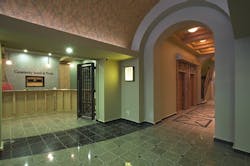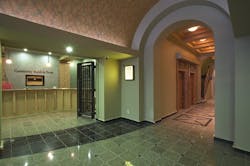Flood of 2008: Guaranty Bank & Trust
Core community values have always been the focus of Guaranty Bank & Trust in Cedar Rapids, IA. For three generations, this independent, locally owned financial institution has favored a neighborhood approach to banking, reflected by local decision-making, local investments, local involvement, and a "for-your-kind-of-life" adage. Home and business owners in all four quadrants of the city have some personal connection to Guaranty Bank through its branch offices, but its downtown operations - housed within an 1890s-era, 6-story, red-stone structure on the corner of Third Street SE and Third Avenue SE - are something special.
Special became extraordinary when, in early October (less than 4 months after the Cedar River swelled, overflowed, and ravaged the heart and soul of Cedar Rapids), cleaning, rebuilding, and restoration were complete. Main bank operations staff rejoined upper-floor building tenants, who had returned to their suites in late July, to celebrate the reopening of this architectural treasure in a salute to the city's spirit and determination.
"I believe in downtown," says Robert D. Becker, Guaranty Bank & Trust president and CEO. "We never seriously considered not coming back. Once you start questioning your decisions, you slow down the process. After the flood, my No. 1 priority was to keep it moving forward." Becker's engineering background helped spearhead efforts; the course deemed most expedient was to rebuild the facility as it was just months earlier. Fully supporting these conclusions were the bank's board of directors and another individual with a vested interest: Guaranty Bank Chairman Harold M. Becker, Robert's father.
Actions were swift and deliberate ... much like the flood itself.
In Retrospect
On Wednesday, June 11, as the river continued to rise, Robert Becker remembers calling the downtown and branch staffs together. Fortunately, Becker and his executive team had a good disaster-recovery plan already in place for actual operations, which were the most critical concern. "[Because] the downtown location is our telecommunications hub, we had put live back-up sites into play in Des Moines, IA, about 2 years earlier. We also moved servers and our VoIP phone system; as a result, our internal systems never missed a beat."
Once it was determined that all critical banking systems were secure, the focus turned to sandbagging the physical assets of the building: the vaults and safe-deposit boxes, which were located in the basement. At the same time, workers elevated vulnerable 1st-floor office equipment and furniture above the recommended 3-foot planes, still not anticipating the impending doom. "We did it as a proactive move," says Christine Crosby, senior vice president, retail banking, at Guaranty Bank, "never truly believing we would be affected since the building had never taken on water, not even in the basement, in 108 years."
By early Thursday morning, downtown Cedar Rapids was being evacuated. Robert Becker, however, stayed until 3 p.m. "I can tell you, I felt doom coming then," recalls Becker, noting his alarmed reaction as two busloads of prisoners from the local jail drove by his establishment on their way to higher ground. "I could see the water coming, and I thought what we had done was great, and that we were going to survive. And, then, to wake up to news that a hospital several blocks further from the river had to be evacuated - I expected the worst. I thought our main building would be 18- to 20-feet under water; in the end, we measured it at right around 40 inches on the street level."
Response and Relationships
A handful of days passed before access to the downtown area was allowed. Becker and the Guaranty Bank team, however, turned those crucial first days of physical immobility into a whirlwind of constructive planning. Contracts for demolition, clean-up, and rebuilding were secured; once entry into the structure was allowed, work began. "Our biggest advantage was the fact that we had a good reputation with our contractors - we're respectful and positive, we always pay, and we don't dispute bills. That carries you a long way."
Crosby notes that projects started small and grew, "but we kept our contractors and subcontractors busy. Then, as everything progressed, and we got the building permits, they were able to tackle the bigger projects." The building was quickly cleaned and decontaminated, with microbiological samples taken and IAQ tested. Power and access were restored earlier than anticipated, and all phone lines were replaced. Although upper-story tenants were back in business on July 25 (much sooner than most other downtown building occupants), Guaranty Bank extended further goodwill by offering each tenant a 1.5-month rent abatement.
For banking customers, the Internet became a lifeline and a primary communication information resource; Guaranty Bank supplemented this tool with letters and phone calls.
"The big story was safe-deposit boxes," says Becker. Crosby orchestrated the plan, which began with clearing, sanitizing, and lighting a path down to the lower-level vault. Just 6 days after bank staff first re-entered the premises, customers were escorted to their boxes. "As they witnessed their boxes being opened, water would gush out, and the usual response was, ‘I hoped mine would be dry.' Then, we carried each individual's upstairs, where we had set up clean stations with antimicrobial cleaning, rinse tanks, and plastic bags - and lots of staff to offer assistance."
Although not contractually obligated, Guaranty Bank built a cleaning room inside of an undisclosed facility for a contract company that could clean, fumigate, and dry the contents of customers' safe-deposit boxes, starting at a nominal fee of $25. "We picked up most of the expense, but we felt really good about that service," explains Becker. "A month later, other banks came in, saw our set-up, and asked us to help out."
Restoration on the Fast Track
Today, safe-deposit boxes are being repositioned at levels above the 3-foot line, and all utilities have been relocated to higher points. Becker was able to appeal to the city about electrical-code issues that he felt were "misguided," and he won the argument - thanks to his engineering mindset and perseverance.
Momentum was tempered with practicality in the rebuilding and restoration of the bank's lower level and first floor. Now, wallpaper covers areas previously paneled in wood; countertops have been patched and reused; office partitions have been cleaned, refurbished, or replaced; the granite floor remains intact, along with the ceiling; carpet has been replaced; and vault mechanisms glisten after cleaning. "We're makeshifting some of it," says Becker, "but you won't see any lack of quality."
In fact, you won't see a lack of anything at the refurbished downtown bank or throughout Guaranty Bank & Trust's operations. Pre- and post-flood, this customer-driven organization continues to prove to Cedar Rapids residents its commitment: "For your kind of life."
More Flood Stories:
-
Mercy Medical Center - By Jana J. Madsen
-
Alliant Energy Tower - By Jenna M. Aker
-
The University of Iowa - By Leah B. Garris
-
City of Cedar Rapids - By Jenna M. Aker
-
Guaranty Bank & Trust - By Linda K. Monroe
-
Quaker Oats - By Jana J. Madsen
-
Cedar River Tower - By Linda K. Monroe
Linda K. Monroe, former editorial director at Buildings magazine, is now an editorial advisor to the brand.

